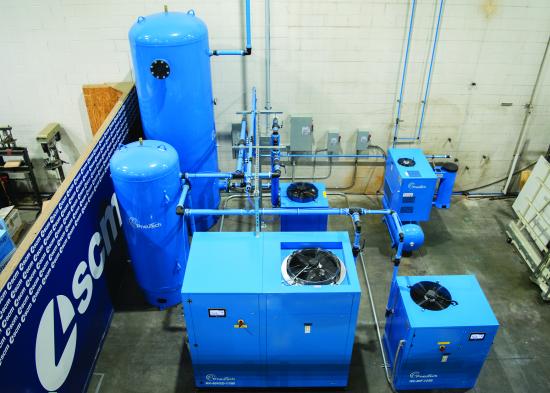
The SCM compressed air system includes three compressors of different sizes, wet and dry air tanks, and an air dryer. All three compressors can be used individually or in any combination.
What’s the best way to meet peak CFM demand events that only happen once or twice a year? That was the challenge for SCM Group North America, an industrial woodworking equipment provider headquartered in Duluth, Georgia. A three-compressor system manufactured by PneuTech made sure they could meet the demand during air-intensive “Dealer Weeks” while keeping energy costs and service requirements low the rest of the year.
Challenge: Ramping Up Demand for “Dealer Week”
SCM Group distributes high-end woodworking equipment through a nationwide network of dealers, ranging from timber systems and large CNC machines for industrial manufacturers to band saws, sanders and joiners for hobbyists and small shops. Each January, dealer representatives from across the eastern U.S. gather at their showroom outside Atlanta to see all the latest and greatest equipment in action.
During Dealer Week, they needed enough compressed air to power multiple machines at a time all day long. Keeping simultaneous demos running for all their top machines required airflow of up to 400 cubic feet per minute (CFM). However, outside of Dealer Week, their compressed air demands were quite modest. On a typical day, they only needed 20 CFM to power their dust collection system and pneumatic tools for their dock and warehouse crating areas.
Previously, they had one 40 HP fixed-speed compressor to service both the showroom and the warehouse and dock areas. The compressor was too large for their daily needs but not large enough to handle all of the equipment they wanted to demo at once during Dealer Week. In addition, a failure during Dealer Week had once left them scrambling for a mobile rental backup. That’s when Adam McCracken, the Logistics and Warehouse Manager for SCM Group in Atlanta, contacted WSI Machinery, a PneuTech equipment dealer in Illinois.
McCracken knew that he wanted a two (or more) compressor solution so he would always have a backup in-house. “I always try to plan ahead,” he says. “I hope for the best and plan for the worst.” Having multiple compressors would ensure that they would have enough air to keep basic operations and at least a few demos running even if one compressor was down.
Two Compressors or Three? How a Multiple-Compressor Solution Reduced Costs
SCM was initially considering two 40 HP fixed-speed rotary screw compressors, each capable of delivering about 190 CFM. The compressors would be linked with a master control system to equalize compressor use. A single compressor would run on days when they needed less air, and the two would work together when demand was high. This would have worked—but was it the best option?
After talking to WSI and PneuTech about their needs, SCM settled on a more unusual solution: three compressors of varying sizes. An energy analysis showed that the three-compressor system would save energy and reduce costs over the complete lifecycle.
The system proposed by WSI and PneuTech included three different sizes of rotary screw air compressors in addition to a refrigerated air dryer and wet and dry air tanks.
- A 7.5 HP fixed-speed rotary screw compressor with integrated dryers, filtration and a 72-gallon air tank provides plenty of CFM for daily operations, including the dust collection system, nail guns for the crating area and other pneumatic equipment in the warehouse and dock.
- A 60 HP variable speed drive (VSD) rotary screw compressor serves as the main compressor for the showroom. VSD allows the compressor to ramp air production up and down according to actual usage. It is used for Dealer Week and for new equipment setup and testing.
- A 40 HP fixed-speed compressor serves as a backup and kicks on during high demand when the 60 HP VSD can’t keep up. By itself, it is still large enough to run a small number of critical demos during Dealer Week or handle equipment setup and testing.
Together, the three compressors can deliver up to 455 CFM at 115 PSI. A valve system allows the compressors to be run individually or in any combination to support both warehouse and showroom activities; they can easily turn on any two compressors together or even all three for events with especially high demand. The compressors are WiFi and Bluetooth® capable and can be controlled using a secure, proprietary app via a smartphone or tablet.
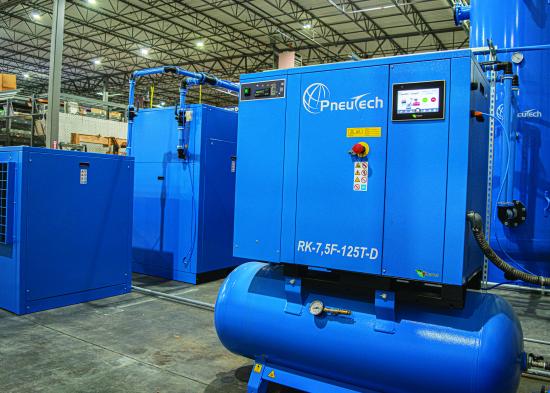
The 7.5 HP fixed-speed compressor, with integrated dryer and 72-gallon tank, supplies air for daily needs, including the warehouse, dock and dust collection system.
Compressed Air System Design for Lowest kW/100scfm
|
The system does not require a complex master controller to operate the units in tandem. It is set to automatically add capacity if the compressor is not keeping up with demand.
- When the large 60 HP VSD compressor is running, pressure for the showroom is set to 108 PSI. Because it is variable speed, it automatically ramps up air production to meet demand up to its maximum capacity of 260 CFM.
- If demand exceeds this point, pressure in the system will start to fall; when pressure drops to 104 PSI, the 40 HP compressor kicks in automatically to provide an additional 167 CFM (for a maximum of 427 CFM for both compressors together).
- If demand still exceeds supply, the 7.5 HP compressor kicks in when pressure drops to 100 PSI, providing an additional 28 CFM of capacity.
This system ensures that pressure does not drop below the 95 PSI required for most of their machines, even during their highest demand events. This allows SCM to run multiple demos simultaneously during Dealer Week and support high-demand applications such as their hot air fusion machines. McCracken says, “It gives us a lot of peace of mind. We don’t have to worry about a situation where we’re in the middle of a demo and start running out of air. The system recognizes if one compressor isn’t keeping up and will automatically turn on another compressor to maintain the pressure we need.”
Two large storage tanks (400 gallons wet storage and 1060 gallons dry storage) are used for the showroom to provide ready air for high-demand events and increase the efficiency of the air dryer. On days when they are setting up or testing new equipment or running small individual demo sessions in the showroom, they can quickly fill the tanks using the 60 HP VSD compressor and then turn the large compressor off and use the 7.5 HP to meet their ongoing CFM requirements.
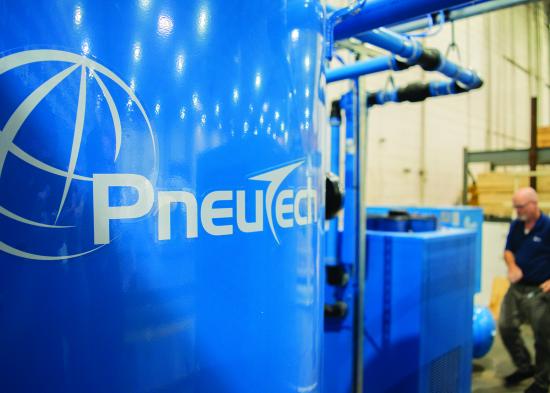
Wet and dry storage tanks provide ready air for high-demand events and increase the efficiency of the air dryer.
SCM also installed a new distribution piping system. They chose aluminum compressed air piping from Unipipe. The modular system does not require special tools or a licensed plumber for installation and is rated for up to 232 PSI.
SCM Group North America System ComponentsCompressors
Dryers
Filtration
Storage
Distribution Piping
|
Calculating the Cost Savings: Two Air Compressors vs. Three
Capital equipment costs were only slightly higher for the three-compressor system than for the two-compressor system initially proposed. SCM saved $10,000 that would have been spent on the controller for the two-unit system. This offset the cost of the additional 7.5 HP compressor proposed. The small compressor is significantly more cost-effective to operate and maintain than the 40 HP fixed-speed initially proposed. Using the small compressor for normal operation outside of Dealer Week will save energy and reduce the total lifetime costs for the system. Here’s how the three-compressor system saves energy.
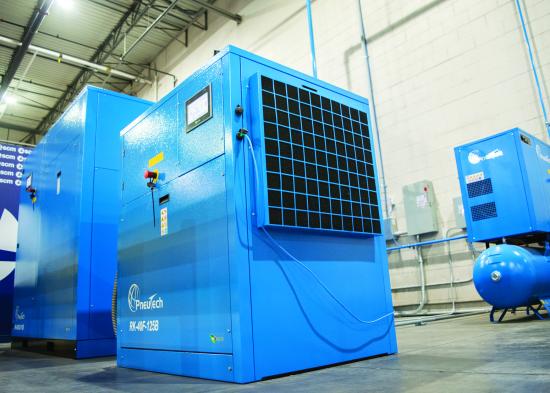
The two large compressors provide air to the showroom during “Dealer Week” and other high-demand days. Shown: PneuTech RK Series 60 HP VSD (back) and PneuTech RK Series 40 HP fixed-speed (front).
Two 40 HP Fixed-Speed Air Compressors
- The 40 HP fixed-speed compressors were capable of delivering up to 190 CFM each. On days when demand was only 20 CFM—about 95% of the time—the compressor “on duty” would be sitting idle (unloaded) most of the day. The compressors draw about 10 kW at zero flow and about 35 kW while loaded. If operating at 10% capacity for a ten-hour day, the compressor would consume ~125 kWh of electricity per day (10 kW x 9 hours + 35 kW for 1 hour).
- With both 40 HP compressors on and loaded, total energy use would be ~700 kWh per 10-hour day.
- Out of an estimated 2500 runtime hours annually, the 40 HP fixed speed would be on and idle for at least 2160 hours, using 21,600 kWh per year while not producing any air. At $0.10 per kWh, this adds up to $2,160 per year in wasted energy.
Three-Air Compressor System
- In contrast, the 7.5 HP compressor draws just about 5.5 kW while fully loaded. Even assuming the compressor is working all day, this adds up to just 55 kWh for a 10-hour day—less than half the cost of running the 40 HP fixed speed.
- The 60 HP VSD draws about 50 kW at maximum capacity. The 40 HP fixed speed draws 35 kW when loaded.
- If all three compressors run together, they would draw a maximum of 90.5 kW and deliver 455 CFM. However, it would be very rare for all three compressors to run simultaneously, and this would likely be for only very short times. A more typical draw during Dealer Week would be up to 85 kW to operate the 60 HP VSD and 40 HP fixed speed together.
- In practice, savings are likely to be even greater, as the system is not likely to be operating with both large compressors at maximum capacity for the entire day. The VSD motor allows the 60 HP compressor to adjust the motor speed to match demand, allowing SCM to deliver precisely the amount of air needed from moment to moment. This provides additional energy savings.
|
|
Two-Compressor System (2 x 40 HP fixed-speed compressors) |
Three-Compressor System (7.5 HP fixed-speed, 60 HP VSD, 40 HP fixed-speed) |
|
Energy draw, normal operations 2400 hours annually @~ 20 CFM |
Unloaded Power Usage 10 kW x 2,160 = 21,600 kWh X 0.10/kWh= $2,160
Loaded Power Usage 35 kW x 360 = 12,600 kWh x 0.10/kWh= $1,260 |
Unloaded Power Usage 2.5 kW x 740 = 1,850 kWh X 0.10/kWh= $185
Loaded Power Usage 5.5 kW x 1,680 = 9,240 kWh x 0.10/kWh = $924 |
|
Energy draw, Dealer Week and other high-demand days (~380 CFM) 100 hours annually |
70 kW x 100 = 7,000 kWh X 0.10/kWh= $700 |
70 kW x 100 = 7,000 kWh X 0.10/kWh= $700 |
|
Total Estimated Annual Energy Costs |
$4,120 |
$1,809 |
* numbers in this chart are generalized to not be brand specific
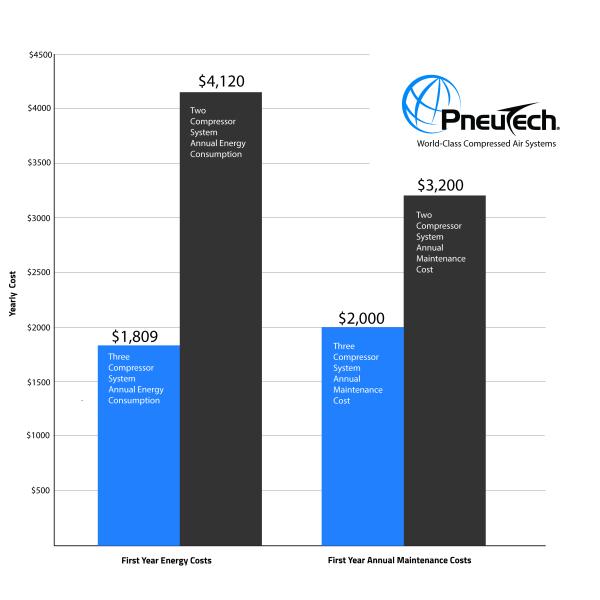
The Bottom Line: A Flexible System that Reduces Operating Costs
In addition to energy savings, the three-compressor system offers other benefits for SCM, as well.
- The 7.5 HP compressor is easier to operate and maintain, using less oil and requiring less time for routine maintenance.
- The small compressor is significantly quieter and throws off less heat, creating a more pleasant working environment around the warehouse and dock.
- Using the small compressor for routine daily operations minimizes runtime for the more expensive large compressors, which reduces maintenance requirements and will extend their service life.
- The two larger compressors still get runtime through the year as they test larger machines for shorter periods of time, which ensures that the oil keeps moving to eliminate any moisture from building up inside the compressors.
- The three-compressor system is highly flexible, allowing them to adjust their air production for the requirements of the day. They have enough extra capacity in the system to support future growth, as well.
- The system has built-in redundancy; if any of the compressors is out of service, the others can be switched on to pick up the slack. Either of the larger compressors, in combination with the 7.5 HP, has enough capacity to support their most critical needs during Dealer Week.
The system was installed in March of 2022 and has performed well since installation. The three-compressor system works for SCM because of the high variability in their demand. While it might not be right for every application, it gives SCM the flexibility they need to optimize performance for both daily operations and annual high-demand events.
McCracken says, “This is the best thing we could ever have done. This is a solution that satisfies all of our needs. And WSI and PneuTech were there every step of the way to answer all of our questions.”
About the Author
Derrick Taylor has more than 20 years of experience in the compressed air industry as the co-owner of Fluid-Aire Dynamics and current General Manager of PneuTech. PneuTech distributes high-quality industrial air compressors and compressed air accessories. For more information visit https://pneutech.com/usa/about/.
To read similar articles on Compressed Air System Assessments please visit
https://www.airbestpractices.com/system-assessments.
Visit our Webinar Archives to listen to expert presentations on Compressed Air Fundamentals at https://www.airbestpractices.com/webinars.




